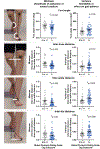Determinants of gait dystonia severity in cerebral palsy
- PMID: 36701240
- PMCID: PMC10392706
- DOI: 10.1111/dmcn.15524
Determinants of gait dystonia severity in cerebral palsy
Abstract
Aim: To determine the movement features governing expert assessment of gait dystonia severity in individuals with cerebral palsy (CP).
Method: In this prospective cohort study, three movement disorder neurologists graded lower extremity dystonia severity in gait videos of individuals with CP using a 10-point Likert-like scale. Using conventional content analysis, we determined the features experts cited when grading dystonia severity. Then, using open-source pose estimation techniques, we determined gait variable analogs of these expert-cited features correlating with their assessments of dystonia severity.
Results: Experts assessed videos from 116 participants (46 with dystonia aged 15 years [SD 3] and 70 without dystonia aged 15 years [SD 2], both groups ranging 10-20 years old and 50% male). Variable limb adduction was most commonly cited by experts when identifying dystonia, comprising 60% of expert statements. Effect on gait (regularity, stability, trajectory, speed) and dystonia amplitude were common features experts used to determine dystonia severity, comprising 19% and 13% of statements respectively. Gait variables assessing adduction variability and amplitude (inter-ankle distance variance and foot adduction amplitude) were significantly correlated with expert assessment of dystonia severity (multiple linear regression, p < 0.001).
Interpretation: Adduction variability and amplitude are quantifiable gait features that correlate with expert-determined gait dystonia severity in individuals with CP. Consideration of these features could help optimize and standardize the clinical assessment of gait dystonia severity in individuals with CP.
© 2023 Mac Keith Press.
Figures



Comment in
-
Future directions for the assessment of gait dystonia in cerebral palsy.Dev Med Child Neurol. 2023 Jul;65(7):865-866. doi: 10.1111/dmcn.15523. Epub 2023 Jan 30. Dev Med Child Neurol. 2023. PMID: 36717760 No abstract available.
Similar articles
-
Gait features of dystonia in cerebral palsy.Dev Med Child Neurol. 2021 Jun;63(6):748-754. doi: 10.1111/dmcn.14802. Epub 2021 Jan 7. Dev Med Child Neurol. 2021. PMID: 33411352 Free PMC article.
-
A Novel Video-Based Methodology for Automated Classification of Dystonia and Choreoathetosis in Dyskinetic Cerebral Palsy During a Lower Extremity Task.Neurorehabil Neural Repair. 2024 Jul;38(7):479-492. doi: 10.1177/15459683241257522. Epub 2024 Jun 6. Neurorehabil Neural Repair. 2024. PMID: 38842031
-
Kinematic upper limb analysis outperforms electromyography at grading the severity of dystonia in children with cerebral palsy.Clin Biomech (Bristol). 2024 Jul;117:106295. doi: 10.1016/j.clinbiomech.2024.106295. Epub 2024 Jun 17. Clin Biomech (Bristol). 2024. PMID: 38954886
-
[Dystonia in cerebral palsy; what are the treatment options?].Ned Tijdschr Geneeskd. 2022 Feb 16;166:D5868. Ned Tijdschr Geneeskd. 2022. PMID: 35499589 Review. Dutch.
-
Treatment of movement disorders in dystonia-choreoathtosis cerebral palsy.Handb Clin Neurol. 2013;111:197-202. doi: 10.1016/B978-0-444-52891-9.00019-1. Handb Clin Neurol. 2013. PMID: 23622164 Review.
Cited by
-
Quantifying Arm and Leg Movements in 3-Month-Old Infants Using Pose Estimation: Proof of Concept.Sensors (Basel). 2024 Nov 27;24(23):7586. doi: 10.3390/s24237586. Sensors (Basel). 2024. PMID: 39686123 Free PMC article.
-
Local Field Potential-Based Programming for Deep Brain Stimulation in Pediatric DYT1 Dystonia.Mov Disord Clin Pract. 2025 Feb;12(2):249-252. doi: 10.1002/mdc3.14283. Epub 2024 Dec 3. Mov Disord Clin Pract. 2025. PMID: 39628113 No abstract available.
-
Caregiver descriptions of dystonia in cerebral palsy.Ann Clin Transl Neurol. 2024 Feb;11(2):242-250. doi: 10.1002/acn3.51941. Epub 2024 Jan 4. Ann Clin Transl Neurol. 2024. PMID: 38174361 Free PMC article.
-
Mice born preterm develop gait dystonia and reduced cortical parvalbumin immunoreactivity.bioRxiv [Preprint]. 2024 Feb 2:2024.02.01.578353. doi: 10.1101/2024.02.01.578353. bioRxiv. 2024. Update in: Pediatr Res. 2025 Jun;97(7):2475-2484. doi: 10.1038/s41390-024-03603-8. PMID: 38352408 Free PMC article. Updated. Preprint.
-
Evolving understanding of CP phenotypes: the importance of dystonia.Pediatr Res. 2024 Jun 26. doi: 10.1038/s41390-024-03327-9. Online ahead of print. Pediatr Res. 2024. PMID: 38926549
References
-
- Eggink H, Kremer D, Brouwer OF, et al. Spasticity, dyskinesia and ataxia in cerebral palsy: Are we sure we can differentiate them? European Journal of Paediatric Neurology 2017; 21: 703–706. - PubMed
-
- Rice J, Skuza P, Baker F, Russo R, Fehlings D. Identification and measurement of dystonia in cerebral palsy. Dev Med Child Neurol 2017; 59: 1249–55. - PubMed
-
- Steeves T, Day L, Dykeman J, Jette N, Pringsheim T. The prevalence of primary dystonia: a systematic review and meta-analysis. Mov Disord 2012; 27: 1789–96. - PubMed
Publication types
MeSH terms
Grants and funding
LinkOut - more resources
Full Text Sources
Medical
Miscellaneous

